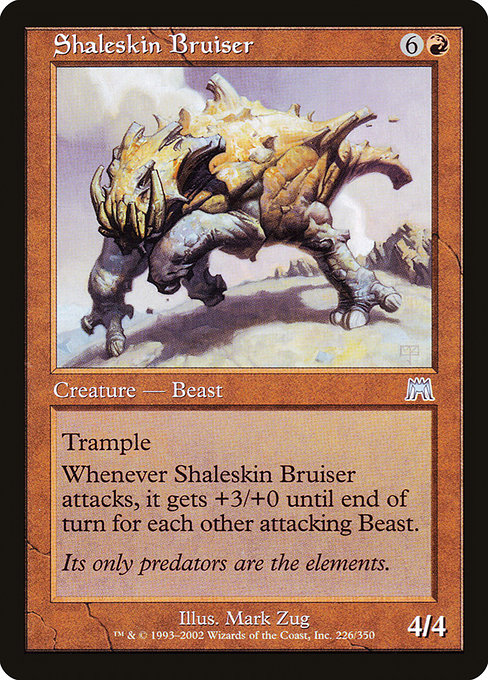
Image courtesy of Scryfall.com
Statistical Insight into Card Synergy Networks with Shaleskin Bruiser
Beast tribes have always thrived on the edge between raw power and careful compounding. When you look at Shaleskin Bruiser, a red combat behemoth from Onslaught, you’re seeing a template for how a single card can radiate impact across an entire swarm. This article dives into how this uncommon creature creates measurable synergy networks—where the value isn’t just its own stats, but the way it scales with every other attacking Beast on the battlefield 🧙🔥💎⚔️.
Card snapshot: the math in a single frame
- Name: Shaleskin Bruiser
- Set: Onslaught (ONS), 2002-10-07
- Mana cost: {6}{R}
- Type: Creature — Beast
- Rarity: Uncommon
- Power/Toughness: 4/4
- Keywords: Trample
- Oracle text: Trample. Whenever this creature attacks, it gets +3/+0 until end of turn for each other attacking Beast.
- Flavor text: Its only predators are the elements.
From a numeric perspective, the card is a four-power creature that remixes the battlefield math in real time. If you attack with N Beasts, including Shaleskin Bruiser, the Bruiser gets a buff of 3 × (N − 1) to its power for that combat, until the turn ends. So on a four-Beast attack, Bruiser swings as a 13/4. That kind of scaling is the heartbeat of Beast-based synergy networks—where the value isn’t fixed, but emergent from the number of Beasts you coordinate to attack together ⚔️🎲.
Its only predators are the elements.
How the synergy network forms
Shaleskin Bruiser acts as a catalytic node in a Beast-heavy attack sequence. In practical terms, you’re constructing a network where each additional attacking Beast expands the Bruiser’s punch by a linear amount. This creates a few interesting dynamics:
- Attack economy: You’re incentivized to deploy multiple Beasts to maximize the Bruiser’s buff on each swing. The more bodies you commit, the larger the temporary power spike.
- Combat damage planning: Trample isn’t just about getting through blockers; it’s about allocating the damage to pressure your opponent’s life total and resources. A Bruiser that can reach double-digit power in combat makes removal decisions more punishing for an opponent to navigate.
- Tempo and value trades: With a high-power attack, you can force trades that leave you with a bigger battlefield footprint, even if you’re trading one-for-one with blockers.
- Deck-building signals: The card’s color identity and fix cost push you toward a red-heavy, Beast-aware strategy. Red’s pump effects, mana ramp, and aggressive tempo options become natural partners to maximize the Bruiser’s trigger window.
Practical build notes: turning numbers into decks
In draft and sealed, Shaleskin Bruiser is a fearsome drop when the draft wheel leans toward green or other Beasts, but its true home shows up in constructed formats that can sustain a crew of Beasts and a consistent attack cadence. Here are a few guiding ideas for leveraging the Bruiser’s network value 🧙🔥:
- Beast tribal under red: Use Beasts with aggressive bodies to assemble a crowd around the Bruiser. Cards that amplify attack steps or grant haste can help you push through damage before opponents stabilize.
- Recursive and pump support: Pump spells, anthem effects, or combat tricks that untap or untether Beasts can amplify the Bruiser’s buff window, turning a single attack into a scaled event.
- Blocking considerations: The Bruiser’s trample means you’re often pressuring with both offense and resource denial. Carefully chosen blockers can still allow your staples to profitably swing for significant damage.
- Format considerations: While Onslaught-era legality marks this card as a relic in some formats, Legacy, Vintage, and certain casual Commander groups keep older red-Beast strategies breathing. The card’s Legacy and Vintage presence remains a nod to its enduring design traits.
Value, rarity, and collector context
Shaleskin Bruiser sits as an uncommon from Onslaught, with a modern distribution that reflects its era’s design philosophy—big numbers, big surprises, and a price tag that’s accessible for kitchen-table nostalgia and serious collection alike 🧙🔥. As of the latest data, prices for non-foil copies hover around USD 0.18, with foil versions around USD 1.33. European prices show similar modest margins, while the TIX market sits around USD 0.05. For collectors chasing foil art or borderless prints, the card remains a gateway to discussions about the era’s art, layout, and print runs, making it a friendly entrant into the broader Onslaught lineage 🎨.
Beyond raw numbers, the card’s art, by Mark Zug, captures a brutal elegance that pairs perfectly with the flavor text and the brutal math of its torrent of power. If you’re a lover of Nexus-beast lore wrapped in punchy red, Shaleskin Bruiser is a compact case study in how a single creature can seed an entire network of strategy decisions in a single combat phase.
Flavor, art, and cultural resonance
The Onslaught era brought a particular brutal beauty to the table—a time when trample and big swings defined late-game inevitabilities. Shaleskin Bruiser embodies that ethos: a towering beast whose very presence tells you that the battlefield is a graph, and every additional Beast you attack with expands the Bruiser’s reach by a tidy three power points. It’s a design that invites players to think in networks rather than single-card value, a concept that resonates with modern MTG players who enjoy analyzing synergy graphs, trigger chains, and the unpredictable rhythms of combat math 🧙🔥💎⚔️.
Where to take the idea next: cross-promotion and play
If you’re looking to bring this tactical conversation into your everyday desk setup, consider pairing the idea with the product below—the neon mouse pad is not only a desk accessory but also a reminder that MTG strategy thrives on tactile, well-organized play areas. The product page offers a little synergy of its own as a conversation starter for your next league night or casual Friday jam.